#asteroceras
Text
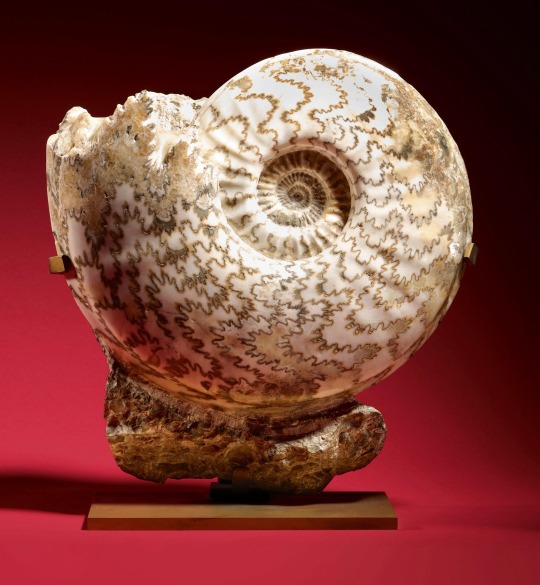
POLISHED AMMONITE
Aegasteroceras sagittarium
205.6–189.6 million years
Scunthorpe, England
Frodingham Ironstone Quarry
37 × 37 × 7 cm (not including base)
Ammonites are fossilised shells of cephalopods with a wide variety of forms, that went extinct 65 million years ago. There are 1,500 known genera of ammonites, all equally important to the study of geology as well as palaeontology. They had a chambered shell that provided buoyancy. With their geometry and beauty, they have captured the human imagination since the Middle Stone Age and have therefore given rise to many origin myths, eventually leading to their name, which means ‘Ammon’s horns’ after the ancient Egyptian god of life and reproduction, who was usually depicted with ram’s horns.
The specimen presented here is an Asteroceras, which is a genus of medium- to large-ribbed ammonites. The shell, rolled up in the manner of a logarithmic spiral, recalls a snail and was polished to reveal beautiful suture lines, carved out of its original iron stone matrix.
Koller Auctions
14 notes
·
View notes
Text
Spectember 25: Ambush
Wafari Drifters (Asteroceras summalignum) are large shelled cephalopods that can be found solely in the shallow sea of Wafari, which separates much of Umasi and N’Jando from each other.
A shallow sea prone to sea grass and relatively calm weather, it is a place of abundant life.
Wafari Drifters, take advantage of their verdant habitats, disguising themselves most commonly as patches of shifting sargassum.
Reaching around ten feed in width due largely to their shells, the sizable sideways aligned beasts have been seen to prey on all manner of fish, as well as the few sea mammals and reptiles that come to feed on their sargassum covering.
Drifters, wait until their prey is right on top of them, completely still until they are in positioned properly,
They jettison their barbed tentacles of which they have six, and their brakes mouth which is on a retractable proboscis to latch onto prey, pumping a blood-thinning toxin that causes the struggling prey to create their own demise. They used their snapping beak and tentacles to tend the corpse into more palatable portions, drawing in dozens of other scavenger species, some which even call the Drifters home.
Their breeding practices are very basal, with females laying eggs that males later fertilize allow the hundreds upon hundreds of little spheres to be carried away on the tide.
Sailors from the numerous cities that ply the Wafari claim that some Drifters have taken to disguising themselves as floating wrecks or other ship debris, hoping to attract curious sophonts. These supposed manesters are said to grow nearly twice as large as their kin, and are willing to work alongside each other, in a manner alien to their less aggressive kin.
This has lead to some speculating they have been influenced by some outside occult force, but so far the “Snatchers” as the sailors call them have yet to be seen or identified by scholars.
#spectember#speculative evolution#speculative biology#fantasy creature#fantasy world#arclund#Original Work#OC
0 notes
Video
fms.fossils
One of my very favourite ammonite fossils I have found at Lyme Regis is this large Asteroceras stellare that split open perfectly from its concretion to reveal both the positive and negative parts of the shell. The ammonites found in these particular rocks are usually very crushed and don't look good, but this one is near perfect. Around 196 million years old and related to living squid and octopuses.
130 notes
·
View notes
Photo

aram vill
azhdarchid/ammonite lad who’s doing his best
fascinated by wristwatches and corporate corruption
grandma was a balearic islands cave goat in a rain coat. convenient
#art#my art#artists on tumblr#aram vill#pterosaur#arambourgiania#ammonite#asteroceras#furry#hybrid#alien#oc#original character#bright shadows#sketch#i know his wings are wrong right now bt jsut. Ignore Them
6 notes
·
View notes
Video
Prepping an Asti #asterocerasobtusum #asteroceras #fossils #fossil #fossilcollector #fossilpreparation #dorset #jurassiccoast #jurassic #jurassicfossils #charmouthbeach #charmouth
#fossilpreparation#asterocerasobtusum#fossilcollector#fossils#jurassiccoast#asteroceras#charmouthbeach#charmouth#dorset#jurassic#fossil#jurassicfossils
3 notes
·
View notes
Photo

Retro vs Modern #17: Ammonites
Ammonites (or ammonoids) are highly distinctive and instantly recognizable fossils that have been found all around the world for thousands of years, and have been associated with a wide range of folkloric and mythologic interpretations – including snakestones, buffalo stones, shaligrams, and the horns of Ammon, with the latter eventually inspiring the scientific name for this group of ancient molluscs.
(Unlike the other entries in this series the reconstructions shown here are somewhat generalized ammonites. They're not intended to depict a specific species, but the shell shape is mostly based on Asteroceras obtusum.)
1830s
It was only in the 1700s that ammonites began to be recognized as the remains of cephalopod shells, but the lack of soft part impressions made the rest of their anatomy a mystery. The very first known life reconstruction was part of the Duria Antiquior scene painted in 1830, but to modern eyes it probably isn't immediately obvious as even being an ammonite, depicted as a strange little boat-like thing to the right of the battling ichthyosaur and plesiosaur.
The argonaut octopus, or "paper nautilus", was considered to be the closest living model for ammonites at the time due to superficial similarities in its "shell" shape, but these modern animals were also rather poorly understood. They were commonly inaccurately illustrated as floating around on the ocean surface using the expanded surfaces on two of their tentacles as "sails" – and so ammonites were initially reconstructed in the same way.
1860s
While increasing scientific knowledge of the chambered nautilus led to it being proposed as a better model for ammonites in the mid-1830s, the argonaut-style depictions continued for several decades.
Interestingly the earliest known non-argonaut reconstruction of an ammonite, in the first edition of La Terre Avant Le Déluge in 1863, actually showed a very squid-like animal inside an ammonite shell, with eight arms and two longer tentacles. But this was quickly "corrected" in later editions to a much more nautilus-like version with numerous cirri-like tentacles and a large hood.
The nautilus model for ammonites eventually became the standard by the end of the 19th century, although they continued to be reconstructed as surface-floaters. Bottom-dwelling ammonite interpretations were also popular for a while in the early 20th century, being shown as creeping animals with nautilus-like anatomy and numerous octopus-like tentacles, before open water active swimmers eventually became the standard representation.
2020s
During the 20th century opinions on the closest living relatives of ammonites began to shift away from nautiluses and towards the coleoids (squid, cuttlefish, and octopuses). The consensus by the 1990s was that both ammonites and coleoids had a common ancestry within the bactridids, and ammonites were considered to have likely had ten arms (at least ancestrally) and were probably much more squid-like after all.
Little was still actually known about these cephalopods' soft parts, but some internal anatomy had at least been figured out by the early 21st century. Enigmatic fossils known as aptychi had been found preserved in position within ammonite shell cavities, and were initially thought to be an operculum closing off the shell against predators – but are currently considered to instead be part of the jaw apparatus along with a radula.
Tentative ink sac traces were also found in some specimens (although these are now disputed), and what were thought to be poorly-preserved digestive organs, but the actual external life appearance of ammonites was still basically unknown. By the mid-2010s the best guess reconstructions were based on muscle attachment sites that suggested the presence of a large squid-like siphon.
Possible evidence of banded color patterns were also sometimes found preserved on shells, while others showed iridescent patterns that might have been visible on the surface in life.
In the late 2010s the continued scarcity of ammonite soft tissue was potentially explained as being the same reason true squid fossils are so incredibly rare – their biochemistry may have simply been incompatible with the vast majority of preservation conditions.
But then something amazing happened.
In early 2021 a "naked" ammonite missing its shell was described, preserving most of the body in exceptional detail – although frustratingly the arms were missing, giving no clarification to their possible number or arrangement. But then just a few months later another study focusing on mysterious hook-like structures in some ammonite fossils concluded that they came from the clubbed tips of a pair of long squid-like tentacles – the first direct evidence of any ammonite appendages!
A third soft-tissue study at the end of the year added in some further confirmation that ammonites were much more coleoid-like than nautilus-like, with more evidence of a squid-style siphon, along with evidece of powerful muscles that retracted the ammonite's body deep inside its shell cavity for protection.
Since ammonites existed for over 340 million years in a wide range of habitats and ecological roles, and came in a massive variety of shapes and sizes, it's extremely likely that their soft anatomy was just as diverse as their shells – so there's no single "one reconstruction fits all" for their life appearances. Still, at least we now have something less speculative to work with for restorations, even if it's a bit generalized and composite, and now that we're finally starting to find that elusive soft tissue there's the potential for us to discover so much more about these iconic fossil animals.
———
Nix Illustration | Tumblr | Twitter | Patreon
#retro vs modern 2022#science illustration#paleontology#paleoart#palaeoblr#ammonite#ammonoidea#cephalopod#mollusc#invertebrate#art#you wait centuries for ammonite soft tissue#and then a bunch turns up all at once
3K notes
·
View notes
Text
Cephalopod Fossils from Lyme Regis, England
My position as a Research Volunteer in the Section of Invertebrate Paleontology (IP) allows me to delve into stories about the collection that I find interesting. One of my research assignments is to investigate the fossils from Lyme Regis, England. The Lyme Regis fossils are part of the 130,000 specimens purchased by Andrew Carnegie from the Baron de Bayet of Belgium in 1903. Some of the Bayet fossils are incorporated into the museum’s Dinosaurs in Their Time (DITT) in the Triassic, Jurassic, Cretaceous, and a special Lyme Regis case that showcases 13 invertebrate and vertebrate fossils.
The village of Lyme Regis is situated on the Dorset Coast, and as such, receives some of the worst weather associated with the English Channel. The Lyme Regis cliffs and beaches have been a fossil hunting graveyard for two hundred years, first made famous by resident Mary Anning (1799 – 1847). When she was just twelve years old she found a large skeleton of a marine reptile known as an Ichthyosaur (literally “fish lizard”). Ichthyosaurs were predators that fed on Jurassic fishes and ammonites. It’s easy to see how she developed a love of fossils after discovering such a magnificent creature as a child. For years, she amassed collections of plesiosaurs, pterosaurs, fish skeletons, and other marine fossils and sold them for a living to paleontologists worldwide. In DITT, there are two examples of Ichthyosaur specimens, a skull (CM 877) and a three-foot-long skeleton (CM 23822). Unfortunately, Mary Anning was not recognized during her life for her accomplishments, probably because she was not a trained paleontologist and she was female. After her death, the collections became widely known to the scientific community, bringing about a better understanding of the paleontology of the Dorset coast.
A fascinating piece of trivia about Lyme Regis is the filming of the 1980 movie, The French Lieutenant’s Women, which depicts the lead male actor, Jeremy Irons, using a simple rock hammer to extract a fossil ammonite from the cliff. If only it was that easy to collect from the 300-meter sheer cliff. My supervisor, Albert Kollar, collected fossils along the Lyme Regis beach in 1999. He opined “most fossils are eroded naturally because of the storm waves coming in from the English Channel that eat away at the rock each year, collapsing to the beach in broken blocks that eventually expose the fossils over time.”
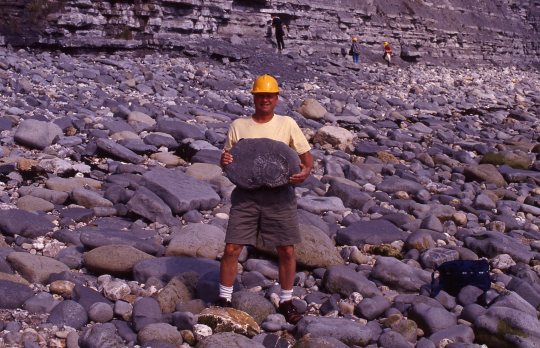
My project was to research the Lyme Regis mollusks i.e., ammonites, nautiloids, and belemnites, update their identification, and review the climate aspects of the Jurassic sea that once covered this part of Europe approximately 199 to 190 million years ago. Paleontologists use marine fossils to interpret past paleoclimates and the paleoenvironments in which the animals once lived. The Jurassic is commonly considered as an interval of sustained warmth without any well-documented glacial deposits at the polar regions. The Lyme Regis fossils are preserved in very discrete layers of limestone strata often named “Lias” by European geologists. The terminology used today is early Jurassic Sinemurian Stage. The fossil mollusks are singular specimen’s that measure approximately 1 inch to 8 inches in diameter. The Carnegie of Natural History collection contains 16 invertebrate specimens from the genera Acanthoteuthis, Asteroceras, Eoderoceras, Liparoceras, Lytoceras, Microderoceras, Nautilus, Radstockiceras, and Xipheroceras.
All Bayet fossils were recorded in the Carnegie Museum Catalog of Fossils. The Cephalopod Catalog contains ammonite, nautiloid, and belemnoid fossils assigned by Bayet and includes details such as collection localities and stratigraphic horizon. Some Lyme Regis specimens are recognized by having two letters “BK” and a painted number, as seen on CM 40666. In 1975, a Swiss paleontologist, Dr. Felix Wiedenmayer, was on a research sabbatical to study fossil sponges at the Carnegie Museum, as well as an expert on Mesozoic ammonites from Europe. He reviewed many Mesozoic ammonites providing updated identification to genus and species, and stratigraphic horizon data, including some of the Lyme Regis ammonite fossils.
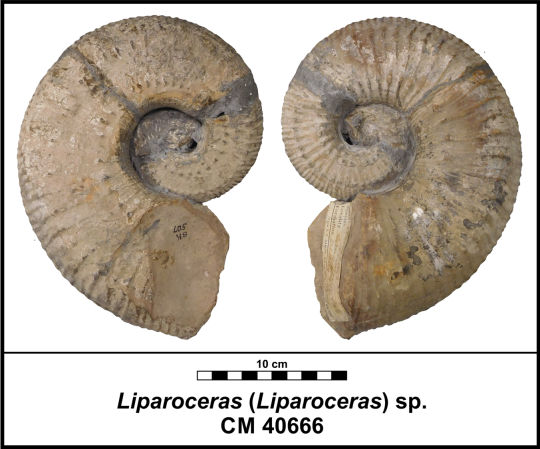
To complete the project, I created a virtual geology, paleontology, and exhibit folder in PowerPoint. This includes photographs of the specimens, a geologic map of Lyme Regis and the Dorset Coast, a Paleogeographic map, the distribution of genus and species in the collection, and references. The photographs in this study were taken by IP Research Associate/volunteer John Harper.
I have had a great experience at the Carnegie Museum of Natural History gaining knowledge about these fossil collections, stratigraphy, and geologic time. Now, I look forward to graduate school in part to study microfossils that lived in the seas during a climate “event” around 56 million years ago during the Paleogene Epoch. This event is called the “Paleocene-Eocene Thermal Maximum” (PETM), and is so named because it demarcates the boundary between these two epochs of geologic time. It has been a pleasure looking at these exceptional cephalopods at the Carnegie Museum, and I look forward to any more potential collaborations in the future.
William Vincett is a research volunteer in the Section of Invertebrate Paleontology and a graduate student at the University of Delaware. Museum employees and volunteers are encouraged to blog about their unique experiences and knowledge gained from working at the museum.
#Carnegie Museum of Natural History#Invertebrate Paleontology#Lyme Regis#Bayet fossils#Carnegie Museum Catalog of Fossils#Fossil#Fossils
132 notes
·
View notes
Text
A thing i absolutely love about ammonites is that you have so many variations in shell shape
You got stuff like Asteroceras
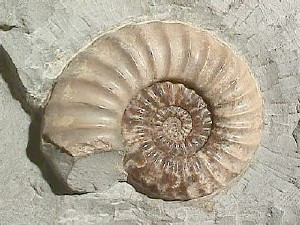
a classic, always recognisable shape, standard spiral and defined chambers. True and tested.
Then you got stuff like Crioceratites
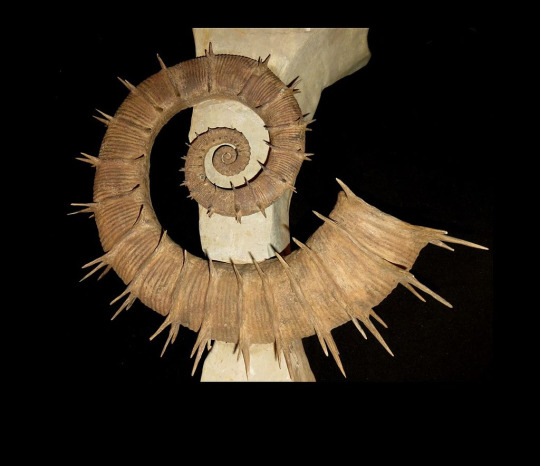
Alright, a more open shell with spikes, what i’d call a bold move, while still staying somewhat true to classical form
But then there’s Didymoceras

Here we have a true innovator, that shell isn’t nearly a spiral any more, real avant garde
But not to be outdone, finally there is Nipponites

A true rebel, they care not for your spiral norms and instead decided to do whatever the fuck they want.
81 notes
·
View notes
Photo
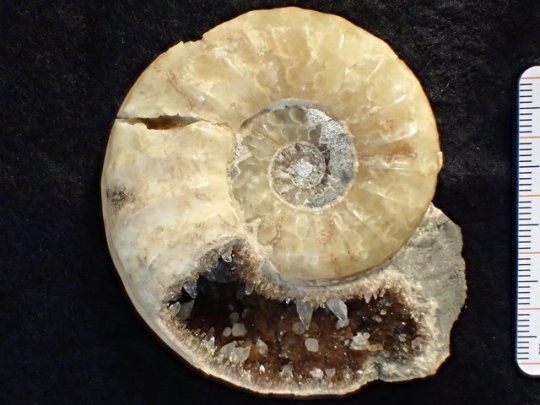
Calcite preserved in the body chamber of an Asteroceras ammonite from Charmouth, Dorset.
From our Palaeontology collections.
13 notes
·
View notes
Text
Interpreting ammonite fossils
Ammonites are such popular and well-known fossils that suggesting they need interpreting may seem ridiculous. But for all their familiarity, there is still a good deal of debate over how they lived and what they did. If nothing else, ammonite experts all agree that they were ecologically diverse, with different species doing different things, and broadly speaking, they can be divided into…
View On WordPress
#Ammonite#ammonite shells#Arietites#Asteroceras#Dactylioceras#Devonian#fossils#Heteromorph ammonites#Macrocephalites
0 notes
Text
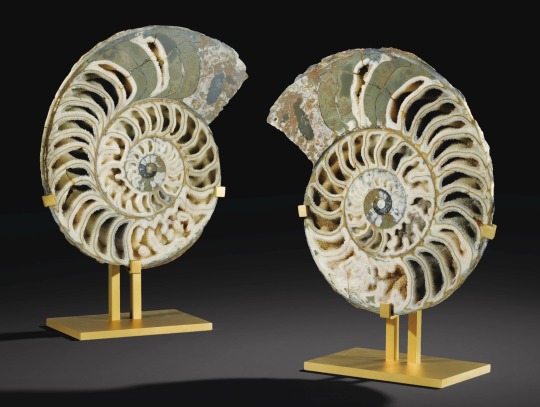
Selected Asteroceras sp ammonite, sliced in two longitudinal sections - Lower Jurassic (190 million years), Scunthorpe, Lincolnshire, England
Sotheby’s
66 notes
·
View notes
Photo
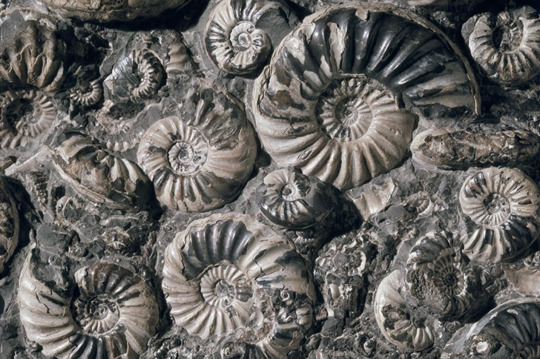
The ammonites Asteroceras and Promicroceras, found near Yeovil in Somerset. Noticed by their distinctive coiled shells
0 notes
Video
fms.fossils
Here's a time lapse video I made a while back showing the process of revealing an ammonite fossil of the species Asteroceras obtusum from within a limestone concretion from the Jurassic Coast. I used pneumatic air scribes (micro chisels) to slowly chip away the rock from around the fossil. This has to be done carefully to avoid damaging the fossil with the chisel tip. Even one touch with the chisel on the fossil can cause nasty damage to the shell. This video represents about 2 and a half hours of work, which is actually pretty speedy for this fossil type! They usually take much longer! The biggest and most intricate fossils can take literally years to reveal from within the rock, due to the difficulty of the process and the care that needs to be taken by the preparator.
#Fossil#shell#ammonite#fossils#geology#air#chisel#pneumatic#Asteroceras obtusum#paleontology#paleoblr#video#timelapse#fossilfriday#instagram#the earth story
479 notes
·
View notes
Photo
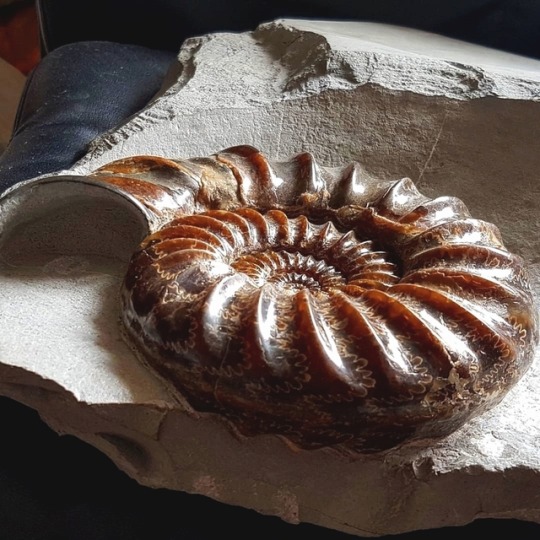
“Here is my favourite ammonite fossil found at Charmouth a couple of years ago. It is of the species Asteroceras obtusum and measures over eight inches across, which is very large for this species. They don’t come much nicer than this!”.credit: @fms.fossils.C’monBoard Science compiles the latest news in the world of science....Check out our science-themed products at cmonstore.com#cosmos #agnostic #secular #space #engineering #noreligion #physics #evolution #godless #galaxy #astronomy #biology #laboratory #freethinker #nogod #skeptic #atheist #nasa #universe #chemistry #atheism #hubble #logic #research #humanist #secularism #goodwithoutgod
#cosmos#agnostic#secular#space#engineering#noreligion#physics#evolution#godless#galaxy#astronomy#biology#laboratory#freethinker#nogod#skeptic#atheist#nasa#universe#chemistry#atheism#hubble#logic#research#humanist#secularism#goodwithoutgod
2 notes
·
View notes
Photo

#ammonite #beachlife #charmouthbeach #jurassic #jurassiccoast #charmouth #dorset #asteroceras #asterocerasobtusum #xipheroceras
#dorset#xipheroceras#jurassiccoast#ammonite#beachlife#charmouth#charmouthbeach#asterocerasobtusum#asteroceras#jurassic
6 notes
·
View notes
Photo
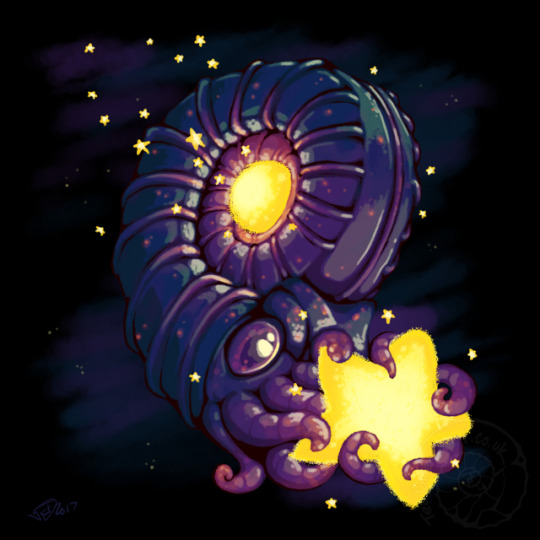
Because you can’t have a kind of ammonite called Asteroceras Stellare without me wanting to draw it covered in stars. It’s just asking for it. This was an experiment in shading! It’s different, but came out interesting.
A video timelapse, wallpaper and other goodies based on this image are available on my Patreon! It’s also on Redbubble and Design By Humans as prints and stickers and things~
| Patreon | Commission Info | Etsy | Redbubble | Design by Humans |
381 notes
·
View notes